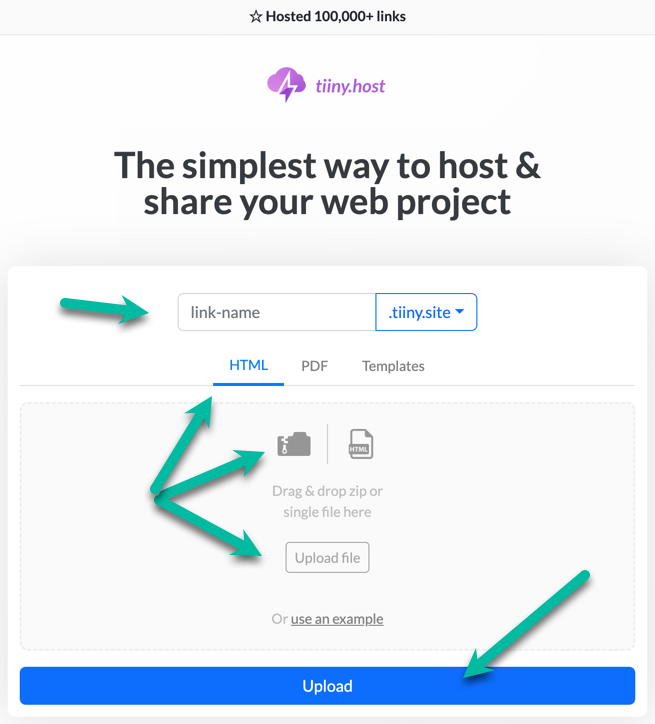- What are Static Website Templates?
- Benefits of Using Static Website Templates
- Fast Loading Speed
- Easy to Customize
- Cost-Effective
- Wide Range of Templates Available
- How to Choose the Right Static Website Template
- Determine Your Needs
- Check for Responsiveness
- Consider the Features
- Hosting your static website
- Next steps
- FAQ: Static Website Templates
People visiting your website care about what it looks like. They care a lot more than you might think.
However, designing and building a website from scratch is difficult and complicated. It also takes a lot of skill. Not everyone has the time or skillset to pull it off.
This is where static website templates come in. They dramatically simplify the task of designing and producing a professional-looking website.
Let’s look at static website templates and why they’re often a great help in developing a stylistic and appealing web presence—a web presence you’re proud of.
And let’s not forget the template’s functionality. That’s important, too.
Here we go.
What are Static Website Templates?
First, what’s a static website? It’s a simple site constructed with HTML, CSS, and JavaScript. The pages are designed, built, and look the same for every visitor to your website. They don’t change unless you edit them. This is their strength. They deliver a consistent message to all your visitors.
RECOMMENDED ARTICLE: How to Build a Static Website.
As I said in the intro, your visitors care about the design of your website. Your site’s appearance is often the difference between a visitor remaining on your site or bouncing away to some other destination. Bouncing visitors are a problem.
If you lack the time or skills necessary to design and produce your website from the ground up, you are in the majority of website owners. You can benefit from using a static website template.
Static website templates are pre-designed web pages you can modify to suit your site’s needs. Many static web templates are available, and many of those are free of cost. You simply choose a style that suits your website, alter the images and content, and publish the site with a great look and feel.
Both you and your visitors will be impressed.
Benefits of Using Static Website Templates
There are many advantages to using a website template. Professional designers design and use templates all the time. Making use of one yourself is a smart move.
Here are some reasons why.
Fast Loading Speed
Websites built with static pages are quick to load. Your page loading speed is another significant quality that improves a visitor’s experience.
A static website template ensures that your pages load immediately when your visitor reaches your site. Your pages are ready and waiting to be viewed.
Dynamic web pages—as opposed to static—must wait until the computer renders them before they are delivered. Dynamic websites are slower than static sites in most cases.
Easy to Customize
Templates are designed with customization in mind. All you must do is open the template, select some text, and replace it with yours. The same process applies to images. Continue replacing text and images throughout the page, and you’re done.
The formatting of the page is left up to the template itself, so you don’t have to worry about columns, margins, borders, or any of those technical details. It’s already done for you.
Cost-Effective
The cost of having a designer create your website from scratch is often prohibitive for small to medium businesses. This is why templates are so popular.
Many static web templates are available free of cost. Templates with more features or a special look are available as a paid option. Prices vary.
Wide Range of Templates Available
With thousands of templates available, you can likely find one to suit your business niche without much trouble. Restaurant sites, for example, tend to have a certain look about them. A good theme captures this look, and your restaurant’s identity is associated with the high quality of your template’s design.
How to Choose the Right Static Website Template
So, choosing the right template for your business niche is important. Here are the steps to take when deciding which web template is right for you.
Determine Your Needs
Think about what you wish to accomplish with your website. What is its purpose? What kind of content will you deliver? Who is your target audience? By narrowing down your options, you will make it much easier to choose from the vast sea of templates available.
Consider the Design
Remember that the niche your business competes in probably has a particular website style. While there are endless options for template features, you must select the template that best suits your brand, your product or service, and the tastes of your target audience.
Look for a template with a pleasing design and a functional layout. That will be the template for you.
Check for Responsiveness
Responsiveness in web design means the ability for your template to look right on any device—desktop computer, smartphone, tablet, TV, whatever.
It is quite important to have a responsive web template. Most template descriptions will tell you if they are responsive. Be sure to check for this feature.
Consider the Features
Finally, recheck your website’s requirements and make sure the template you want has the technical capabilities needed for your business transactions. Will you be communicating with a Content Management System (CMS)? Do you need forms? Many other features are available with static websites, but your template must support them.
Hosting your static website
Visit Tiiny.host for fast, secure, and easy hosting of your static website.
Once you visit the homepage at Tiiny.host, you are three simple steps from your project being live on the web.

- Enter the link-name for your site.
- Choose HTML, then drag and drop or upload your zipped website file.
- Click the big blue “Upload” button.
That’s it!
Next steps
Tiiny.host offers everything you need for sharing a professional or personal website on the internet.
Tiiny.host customer service is awesome! Contact them directly at Tiiny.host/help and see. They’ll answer your questions about their services, help you with any problems, and explain any issues this article raises.
FAQ: Static Website Templates
What is a static website template?
A static website template provides a pre-designed layout and structure for building static websites. Unlike dynamic sites, which generate content on the fly based on user interactions or database queries, static websites serve the same fixed content to all users. A template typically includes HTML files, CSS for styling, and sometimes JavaScript for basic interactions.
What are the advantages of using a static website template?
- Speed: Static websites generally load faster than dynamic sites because they don’t rely on processing database queries.
- Security: Without a database, the risk of database-related vulnerabilities is eliminated.
- Simplicity: They are often easier to set up and maintain than dynamic sites.
- Cost: Hosting for static websites is generally cheaper and requires fewer server resources.
- Portability: They can be hosted on any web server and easily moved.
Can I add interactive elements to a static website template?
Yes. While “static” suggests fixed content, you can still add interactive elements using client-side scripts like JavaScript. Features like image sliders, dropdown menus, and form validations can be incorporated. However, remember that any content changes would still require editing the source files directly unless combined with a more dynamic solution.
RECOMMENDED ARTICLE: How to make your static website more interactive.



